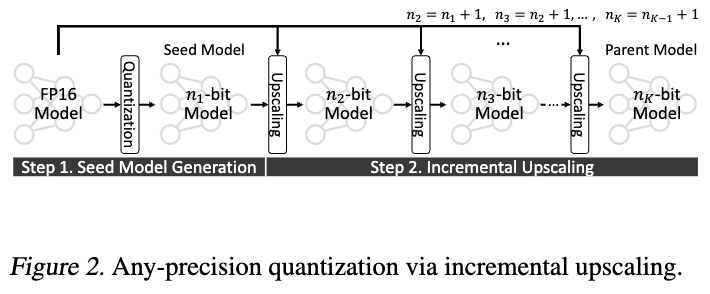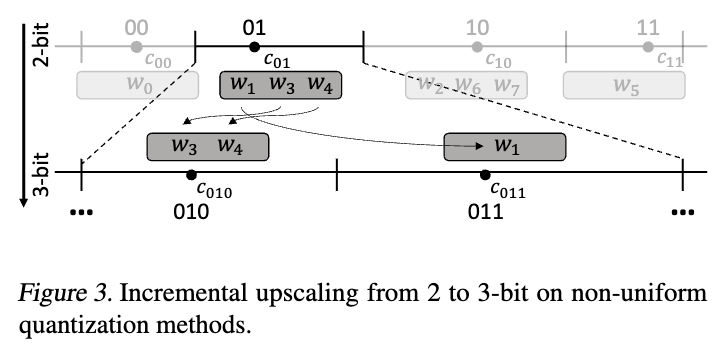Any-Precision LLM: Low-Cost Deployment of Multiple, Different-Sized LLMs
2024-05-23
Keywords: #Flexiblebitprecision #CUDA
0. Abstract
- We propose any-precision quantization of LLMs, leveraging a PTQ framework
- We develop a specialized software engine for its efficient serving. ➡ Our solution significantly reduces the high costs of deploying multiple, different-sized LLMs, by overlaying LLMs quantized to varying bit-widths into a single $n$-bit LLM.
1. Introduction
- Main problem: Limited discussion on mitigating the costs associated with deploying multiple LLMs of varying sizes.
- It exacerbates the already high memory costs of LLM deployment
- It necessitates training of multiple model versions when models of desired sizes are not readily available as open-source.
- Any-precision LLM: Utilization of multiple LLMs with varying sizes by storing only a single large LLM ($n$-bit model) in memory, while avoiding the additional overhead of training multiple LLMs.
- Any-precision DNN: $n$-bit quantized model capable of generating lower bit quantized models simply by taking its MSBs.
- Two challenges of Any-precision LLM
- A practical for any-precision quantization of LLM is needed.
- A new GPU kernel for quantized matrix-vector multiplication is required, which will translate the use of reduced bit-widths in any-precision LLMs into shorter inference times. ← With existing kernels, opting for a model with a lower bit-width does not reduce memory bandwidth usage.
- Contributions
- Packs LLMs quantized to varying bit-widths, such as 3, 4, .. up to $n$ bits, into a memory footprint comparable to a single $n$-bit LLM.
- Despite having to adopt a bit-interleaved (bitplane) memory layout for the support of any-precision, showcases high inference throughput.
2. Background
2.1. GPU Basics
- GPU: Comprises a large number of processing elements called SMs.
- GPUs include multi-level on-chip SRAM caches. Part of the L1 cache can be configured as shared memory, a memory space that can be directly controlled by programmers.
- GPUs use a large number of threads to execute kernels.
- Threads are structured into thread blocks, while these are further organized into a set of warps, with each warp consisting of 32 consecutive threads.
- All threads within a thread block share the same shared memory space.
- All threads within a warp execute the same instruction at the same time.
2.2. LLM Quantization
- Weight-only PTQ: The dominant bottleneck in inference throughput is the memory constraint imposed by the size of weight parameters, rather than computational requirements. QAT is impractical since it has high training expense.
- GPTQ: A pioneering work on weight-only PTQ for LLM
- SqueezeLLM proposes a clustering-based LLM quantization that considers the sensitivity of each weight. (non-uniform quantization)
3. Motivation
3.1. Need for deploying multiple, different-sized LLMs
- Enhance user experience by effectively handling queries with varying latency requirements.
- Speculative decoding: Necessitates multiple LLMs of varying sizes
3.2. Challenges of deploying multiple, different-sized LLMs
- Memory Overhead: As LLMs are typically substantial in size, maintaining even a few additional smaller models incurs significant costs
- Training Costs
- Most open-source LLMs offer only one to three variants of parameter counts.
- Training an LLM is very costly due to its high computational needs and large corpus requirement.
- corpus: A collection of written or spoken material is used to train the language model
3.3. Our Solution: Any-Precision LLM
- Concept
- Any-precision: Highly memory-efficient as it allows the utilization of varying bit-width models by only storing in memory 1) the quantized weights of the parent model, and 2) a set of quantizataion parameters (centroid values)
- Separate deployment: Models of different bit-widths requiring the deployment of separate models, each taking up its own memory space.
- Challenges of Any-Precision LLM
- QAT scheme requires models to be trained from scratch: For LLMs, training is not affordable to most users
- Any-Precision has no regard for memory bandwidth savings: The entire $n$-bit parameters of the parent model are loaded into memory, only then being further quantized into lower bit-width weights by bit-shifting as needed.
- Any-Precision strategy makes sense for CNN models, because they are compute-bound. ↔ LLM inference is highly memory-bound due to its low arithmetic intensity, and the Any-Precision does not offer any benefits in terms of memory bandwidth.
- Memory load of weight parameters is the single primar performance bottleneck. → We incorporate both a low-cost any-precision quantizationi mehthod and a specialized software engine wherein reduced precision inference directly translates to actual speed-ups.
4. Any-Precision Quantization for LLM
4.1. Incremental Upscaling

- Quantizes the model to the minimum supported bit-width ($n_1$) = seed model
- Incrementally upscale one bit at a time, until we obtain the final $n_K$-bit parent model.
- For every incremental upscale from $n_i$-bit model to an $n_{i+1}$-bit model; all params of the $n_i$ bit model are inherited to the $n_{i+1}$-bit model, and a single additional bit is appended to end of each param.
4.2. Non-uniform Quantization-based Incremental Upscaling

5. Specialized Software Engine
5.1. Need for New Software Engine

- Existing GPU kernels:
- GDDR (Graphics Double Data Rate, [S]DRAM, synchronous dynamic ram, different from static ram SRAM) ↔️ L1 cache in each SM: 64B (1.0~1.3, 64bx8burst=64B cache line), 32B (2.0~)
- L1 cache ↔️ SP cache line: 128B
- Bitpacking: Store quantized weights sequentially in a 1-D array. With this representation, the entire weight array has to be loaded even when running a model in a reduced bit-width.
- For example in Figure 4-(a), even when executing a 2-bit or 3-bit model, the full 4-bit values have to be read from memory.
- This is because of the coarse-grained memory access granularity of GPUs, typically 128B.
- Bitplane: Decomposes quantized weights into $n$ bit-vectors, where $n$ is the bit-width. Each bit-vector is formed by taking each bit position of the quantized values. (2-D array, cut off the LSBs -> return 1-D array)
- Any runtime request of reduced bit-width directly translates into proportional speedup, as we can simply load the specified amount of bits.
- Bitplane-based representation is relatively common in CPU GEMM, but not in GPUs.
- Why we can’t use LUT-GEMM
- Lacks support for any-precision as it necessitates of distinct weight layouts to accommodate different bit-widths.
- LUT-GEMM strictly requires weights to adhere to BCQ (binary-coding quantization)- BCQ can’t support the codebook-based non-uniform quantization method
5.2. System Overview

- Centroid tables and bitplanes are stored in global memory.
- Centroid tables have rows equal to the number of output channels, with each row containing $2^k$ values (representing each value $k$ bits can represent), where $k$ refers to the bit-width.
- The rows of the centroid table are scattered across the shared memory
-
The threads load non-overlapping regions of the weight bitplanes
- Thread-Level Operations
 (Assuming bit-width of 4)
(Assuming bit-width of 4) - Each
threadwarpthread loads 32 input activations with their corresponding weights (four 32bit bit-vectors) - Bit-vectors are rearranged so that the bits of each weight align contiguously. = Bit-transpose of eight 4-by-4 bit matrices
- Bit-transposed bit-vectors are shifted & masked to obtain the indices for centroid lookup.
- Dequantization: Fetching centroids from the table in the shared memory
- MAC
- Each
5.3. GPU Kernel Optimization
- GPU kernel optimization techniques aimed at addressing inefficiencies stemming from the characteristics of bitplane-based quantized GEMM
❥ Weight Bitplane Layout Optimization 
- It is preferable for all threads in a warp to access consecution memory locations- for coalescing
- Problem: CUDA limits per-thread max load size = 16B (where granularity for all 32 threads = 128B)
- Weight: 1b; as they are in bitplane
- Activation: 16b; as they are FP16
- Because of this size difference, and per-thread max load size restriction → coalescing can’t be done for activation
- Optimization: Permuting bytes in the weight bitplanes to ensure that threads access activations in a coalesced manner.
- The indices of weights accessed by each thread are no longer sequential → doesn’t matter because it is still coalesced access
- Question: Global access for weights increase 4 times than before optimization
- It’s okay, since it already reuires four memory accesses to load the activations
- No, it’s not because weights take 4 times for every bitplane
❥ Efficient Bit-Transpose 
- Problem: The bit-transpose step is the main overhead amongst the large number of bitwise operations.
- Most widely used bit-transpose algorithm requires 38 bitwise ops. for 8x8 bit matrix
- Optimization: Treat 32b bit-vector = 8 x 4b sub-bit-vectors
- 40 bitwise ops. = (6shifts + 4 ands) * 4b positions < 76 ops for 8x8 bit matrix twice
- For non-power-of-2 bit-widths: Use the next larger bit-width that is a power of 2 (with padding, perhaps) → Shouldn’t matter, memory storage is in the format of bitplane, it only requires more space after memory access
❥ Merging Table Lookups
- Problem: Bitwise operations for the centroid table index calculation (Step 3 in Figure 6) can also become a bottleneck, particularly at small bit-widths.
6. Evaluation
- Quantized models generated from incremental upscaling + non-uniform quantization match SOTA at their respective bit-widths
- Our specialized engine matches/outperforms existing engines while providing memory-efficient any-precision support.
6.1. Any-Precision Quantization Results
- Methodology: We evaluate 4 to 8-bit models obtained through incremental upscaling, using a 3-bit SqueezeLLM model as the seed model
- Compete with 4 to 8-bit SqueezeLLM
- Benchmark:
- Evaluation metrics: Perplexity, zero-shot accuracies
- Results: With just single $n$-bit parent model generated through the incremental upscaling process, we can utilize the full range of 3 to $n$-bit models.